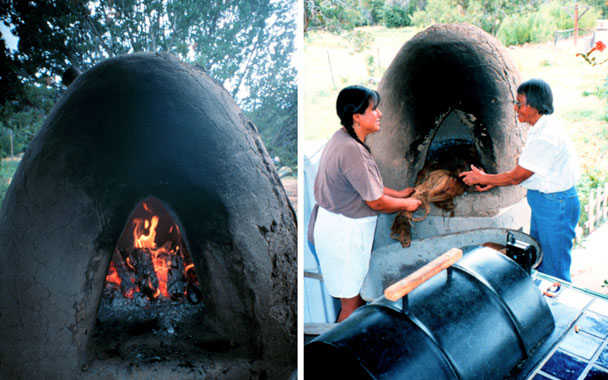For years, I’ve kept a postcard from Morocco that shows a clay oven, domed high like a beehive, flames visible in its low opening and a woman prodding the fire with a long pole. At the top of the card are the words Maroc Typique. Typical Morocco. I bought the card because it looks pretty much like typical New Mexico and possibly Spain, at least judging by the drawing of a very similar oven in Colman Andrews’s book on Catalan cooking. The Moors, of course, lived in Spain, and the Spanish colonized New Mexico. Where the oven originated and with whom, I don’t know, but I do know that the beehive oven, or horno (the “h” is silent), is a very visible part of the landscape as well as the foodscape of the American Southwest. Adobe bricks are set around a base of sandstone, which becomes the oven’s floor, and are piled into the beehive shape; then they’re covered with mud plaster, which is then smoothed into a rounded surface. An opening is left in front, and its door may be carved wood, metal, or simply a stack of bricks. Like micaceous pots, the horno improves the character of any food, for its fire and smoke add savor to whatever is cooked in its warm belly. Anyone who has visited the plaza of the Taos (or any other) pueblo, or a living museum such as Las Golondrias, in Santa Fe, or The Pueblo Cultural Center, in Albuquerque, has no doubt seen an horno. And once you’ve seen one, you start noticing them in backyards here and there, and not just on the pueblos.
One of our early Slow Food dinners was held on the farm of Eremita and Margaret Campos on the Rio Grande, in Embudo, where Margaret has built two hornos for her outdoor cooking school, Comida de Campos. She had actually started that morning, first building a fire of applewood (“Piñon and cedar have too much resin,” she says) inside to heat the walls. Once the coals were about the size of ice cubes, she swept them to the sides, leaving the middle for the food. While the coals were still glowing, she added small applewood branches, which had been soaked in water, to impart smoke and flavor. The meat—pork shoulders, whole chickens, carne adovado, and lamb—some of it wrapped in burlap bags, went into one oven; corn, still in the husk, went into the other. The temperature inside the hornos was about 500°F, but it quickly fell once the food was added, stabilizing at around 250°F. Margaret sealed the oven door with mud so that all the heat was retained. The slow, daylong baking that followed transformed those large cuts of meat into utter succulence.
When it was time to eat, Margaret and Eremita broke the hardened clay seal with a hammer—a very dramatic beginning to dinner—removed the door, and piled the fragrant food onto platters. The chicken was not visually appealing—it was extremely pale, without any suggestion of golden skin—but it was possibly the most delicious chicken I have ever tasted. It was completely tender and moist and suffused with mysterious flavor from the woodsmoke, of course, but I also tasted an aromatic blend of earth, ash, adobe, and fire—the only seasonings besides salt. Like all foods cooked over fire and eaten out of doors, everything cooked in the hornos—including the roasted smoky corn, a classic New Mexico treat called chicos—embodied that absolute robust goodness that you just don’t get cooking any other way.
The horno can also be used in less-traditional ways. Priscilla Hoback, a clay artist who makes micaceous pots, builds a fire in her horno, then adds pots filled with foods such as artichokes, beets, or brisket. She doesn’t seal her oven, but once her vegetables and meats have been cooked and carried to the kitchen, she adds more wood to raise the temperature and slides a pizza onto the oven floor. Following that, she might add a pie and leave it to bake for dessert. Dan Welch, an expert horno builder and pizza cook, uses it like he would an Italian wood-fired pizza oven, sliding pizzas on and off of the hot stone floor with a long baker’s peel while flames curl over the roof of the dome. And a curator at the International Folk Art Museum, Bobbie Sumberg, uses her horno for baking handsome loaves of levain studded with walnuts—eight at a time.
Although horno cooking is quiet and hidden from sight, you’re going to want to have lots of hungry people nearby. In fact, an horno pretty much demands that there will be feasting because it involves such a serious investment of time and firewood. If you’re interested in learning more about horno cooking, take one of Margaret Campos’s classes at Comida de Campos. She’ll be offering a three-day class in October that will combine micaceous clay-pot making with horno cooking: the ideal partnership of earth, food, and fire.




 Pinterest
Pinterest


